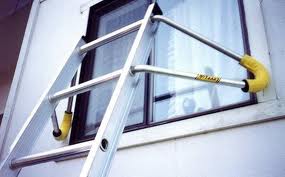Ladder Stand-Off Use And Gutter Damage
False: If Ladder Stand Offs Are Not Used, Gutters Will Be Damaged.
(applies to cleaning gutters, windows,
and dryer vents)
If you are willing to take a moment to read the information below and peruse the photos provided, you will see my explanation regarding the common misconception that in order to avoid damage to buildings, a ladder must have standoffs at the head of it.
This is completely false. Here is why.
Damage is done to building facades or gutters through improper ladder use occurs in 1 of 2 ways.
1. Impact. This typically occurs when an in experienced technician is moving a ladder and either loses control, letting it fall against the building or gutters. A ladder should also never be bounced up and sideways to move it along the building. The weight combined with movement and speed cause dents and damage. This is avoided by having experienced professionals on staff who know how to handle the weight of a ladder properly. Note – this can happen with stand offs on the end of the ladder or not.
2. Angle. Too much pressure against a flimsy gutter can cause damage as well, but that pressure applied depends upon the ladder the angle is placed at. More on angle below.
When a ladder is put up against a building, a worker is leaning a large metal leaver against the building façade. Upon this lever he is placing a large amount of weight – his or her body weight. The amount of pressure against the building façade has to do with the angle of the lever. Whether the ladder has stand offs on the end of it or not is completely besides the point; a ladder with standoffs in the hands of an untrained or inexperienced worker can do just as much damage to the building façade if it is not used correctly. This is because all you have done is put a fancy end on the end of your lever. Rather than have two points of contact being the head of the ladder, you have two points of contact further spread out in the arms of the ladder stand offs. If this is improperly placed against the wall, gutter, or roof, then weight on the ladder or stand offs will cause damage.
When used correctly, a ladder takes most of the weight of the worker and this weight travels down through the length of the ladder and into the ground. A minimal amount of weight presses forward. The further one goes up the ladder, the further the weight on the ladder shifts, eventually putting more stress forward, but not enough to do damage. An experienced worker cleaning gutters or performing any other similar service, will increase the angle of the ladder if they know they are working right at the top of the ladder, thereby increasing the amount of weight going downward to the ground rather than forward against the building.
If used incorrectly, a ladder placed at too steep an angle pushes the ladder forward into the building. This can indeed cause damage, but it is also very likely to cause the feet of the ladder to slip out from under the worker, causing a fall.
Why Use Ladder Stand Offs?
When a ladder is placed against a building and work is being done at the top of the ladder, a worker finds him or herself right up against the building. This creates a very awkward working situation, in which the worker often has to lean backward in order to perform whatever duties they are trying to do. The ladder stand offs allow the head of the ladder to stay about a foot away from the building façade, allowing them to do the work without having their cheek pressed into the building, or having them twist or turn awkwardly trying to do their job. For an example, see the picture below: if the fellow cleaning his windows had that ladder against the brick, he would be right up against the window, making his job quite awkward.
Here’s another great use for ladder stand offs – they can allow you to work around windows you ordinarily couldn’t.
Here is a scenario where stand offs can actually be a hazard. In the pic below, we can see an example of how it can be difficult to tell if the weight of the ladder is resting on the gutter, or on the stand offs on the roof.
If you give an inexperienced worker stand offs and tell them this will protect the gutters, and they then put the angle of the ladder too steep, the point where the ladder crosses over the gutter can and will take the weight of the worker as they climb up the ladder. Damage can be done, once again based on ladder angle. Thinking that the stand offs will take all the weight can lead to scenarios where a steeper angle is used, but the ladder is actually resting on the gutter not the stand offs.
My preference: have an experienced worker perform the service who knows how to use ladders correctly with or without stand offs, and knows how to ensure no damage is done either way. If a homeowner wants to use stand offs to protect their gutters, that makes more sense to me – they don’t climb ladders full time for a living, and may not know or be comfortable with placing ladder on the correct angles, moving a ladder without potentially dropping it, etc.
Q?: But there’s all these great pictures and opinions on the internet about how stand offs protect gutters! Moe, you must be wrong. How do you know?
I performed gutter cleaning, siding cleaning, and window cleaning for years in the field before taking a position as an account manager for Servus Group. I know from firsthand experience what I’m talking about. Am I arguing against ladder stand offs? No, not necessarily. Like any tool, they must be used properly to do the job that they are designed for, and they are not a 1 step solution to a challenge. If used incorrectly, they can actually cause damage to the roof, building siding, or gutter system.
Having ladder stand offs doesn’t mean damage can’t or won’t be done to a building or its gutter system – and inversely, not having them on doesn’t mean damage must have been done. The difference is in the skill and experience of the worker.
At Servus Groupl, we have very experienced technicians in the field, with our two lead ladder workers having 18+ and 12+ years respectively. All of our workers are trained, experienced, and care; that’s how we make sure no damage is done during the performance of our services.
















